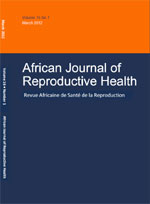
|
African Journal of Reproductive Health
Women's Health and Action Research Centre
ISSN: 1118-4841
Vol. 18, No. 1, 2014, pp. 161-164
|
 Bioline Code: rh14018
Bioline Code: rh14018
Full paper language: English
Document type: Research Article
Document available free of charge
|
|
|
African Journal of Reproductive Health, Vol. 18, No. 1, 2014, pp. 161-164
| fr |
Ogueh, O; Zini, M; Williams, S & Ighere, J
Résumé
Le but de cette étude était de déterminer la prévalence de la morphologie des ovaires polykystiques (MOP) chez les femmes
nigérianes qui fréquentent l'échographie pelvienne. Il s'agissait d'une étude rétrospective des résultats des analyse des ultrasons
de toutes les femmes qui ont participé à l'échographie pelvienne dans un nouvel Centre Hospitalier Universitaire dans le sud du
Nigeria depuis le début de services d'échographie, le 1er mars au 31 juillet 2010. La principale indication pour les analyses était
infertilité (52,7 %) et l'observation la plus courante était fibrome (44,6 %). La morphologie des ovaires polykystiques était
présente chez 12,2% des femmes. En moyenne, les femmes avec le MOP étaient plus jeunes (30,3 v 35,0 ans) et plus susceptibles
de présenter une aménorrhée (33,3 v 7,6%) que les femmes sans MOP, mais il n'y avait pas d'autres différences statistiquement
significatives entre les deux groupes. Cette étude suggère que les femmes nigérianes ont une faible incidence de la MOP.
Mots Clés
Prévalence, morphologie des ovaires polykystiques, Nigeria
|
| |
| en |
The prevalence of polycystic ovary morphology among women attending a new teaching hospital in southern Nigeria
Ogueh, O; Zini, M; Williams, S & Ighere, J
Abstract
The aim of this study was to determine the prevalence of polycystic ovary morphology (PCO) among Nigerian women attending for pelvic ultrasound. This was a retrospective study of the ultrasound scan findings of all women who attended for pelvic ultrasound scan at a new teaching hospital in southern Nigeria from the commencement of ultrasound services on 1 March to 31 July 2010. The main indication for the scans was infertility (52.7%), and the commonest finding was fibroid (44.6%). Polycystic ovary morphology was present in 12.2% of the women. On average women with PCO were younger (30.3 v 35.0 years) and more likely to present with amenorrhea (33.3 v 7.6%) than women without PCO, but there was no other statistically significant differences between the two groups. This study suggests that Nigerian women have a low incidence of PCO morphology.
Keywords
Prevalence, Polycystic Ovary Morphology, Nigerian
|
| |
© African Journal of Reproductive Health
Alternative site location: http://www.ajrh.info
|
|
